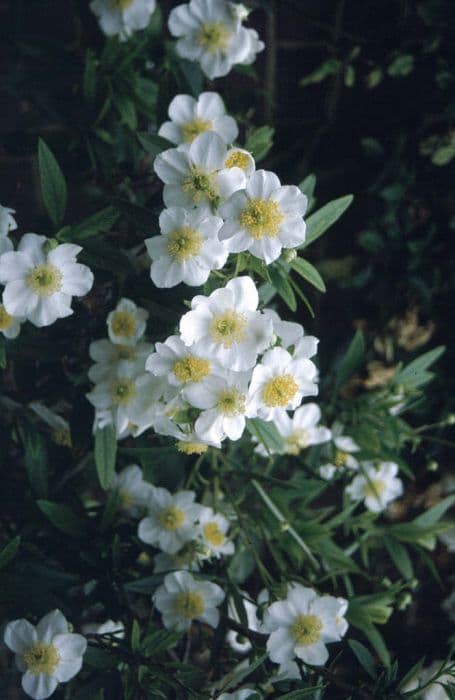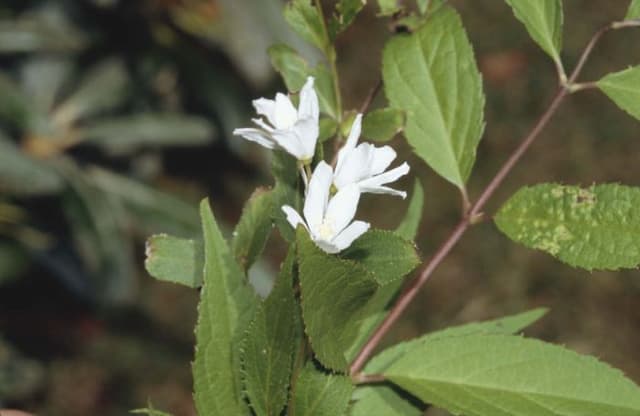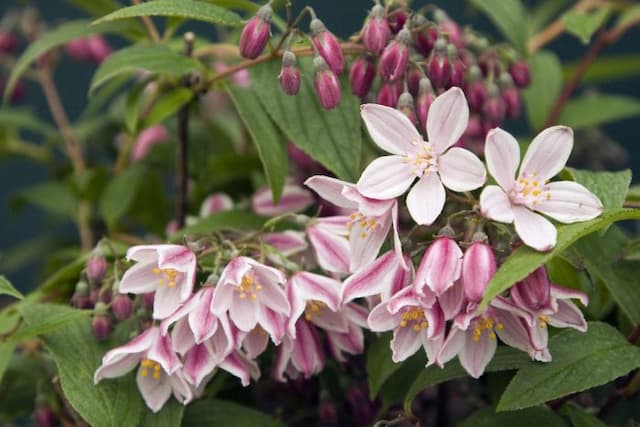Lacecap Hydrangea Hydrangea macrophylla 'Rotschwanz' (Teller Series) (L)

ABOUT
The hydrangea 'Rotschwanz', part of the Teller Series, is a striking ornamental shrub known for its large, flat flower heads. The blooms present a captivating mix of colors, typically ranging from deep pink to violet, and sometimes bearing shades of blue, depending on the soil acidity. Each flower head is a mosaic of smaller florets that have a star-like quality, with the outer ring of florets being significantly larger and showier than the tiny buds at the center. These outer florets tend to have a more pronounced color, while the inner buds might have a subtler hue. The leaves of the hydrangea 'Rotschwanz' are glossy, offering a deep green backdrop that contrasts beautifully with the vibrant flowers. They have a typically ovate shape with somewhat serrated edges, which adds texture to the plant's lush foliage. The overall impression of the plant is one of robustness and abundance, as it displays its striking blooms and rich foliage throughout its blooming season, which generally spans from early summer to late fall, offering a long-lasting display of color in the garden.
About this plant
 Names
NamesFamily
Hydrangeaceae.
Synonyms
Red-tailed Hydrangea, Teller Red Hydrangea, Lacecap Hydrangea.
Common names
Hydrangea macrophylla 'Rotschwanz'
 Toxicity
ToxicityTo humans
The common name for Hydrangea macrophylla 'Rotschwanz' is Hydrangea. Hydrangeas are considered to have a low level of toxicity for humans. However, if ingested, parts of this plant can cause stomach upset, with symptoms such as nausea, vomiting, and diarrhea. Additionally, the plant contains compounds that release cyanide when chewed, so consumption of large quantities could potentially lead to more serious symptoms like dizziness and increased heart rate.
To pets
The common name for Hydrangea macrophylla 'Rotschwanz' is Hydrangea. Hydrangeas are toxic to pets, including cats and dogs. If a pet ingests any part of the plant, they may experience symptoms of poisoning such as vomiting, diarrhea, lethargy, and depression. In more severe cases, it can also lead to cyanide intoxication, which may result in rapid breathing, increased heart rate, and seizures. Owners should seek veterinary care if they suspect their pet has ingested Hydrangea.
 Characteristics
CharacteristicsLife cycle
Perennials
Foliage type
Deciduous
Color of leaves
Green
Flower color
Red
Height
4-6 feet (1.2-1.8 meters)
Spread
4-6 feet (1.2-1.8 meters)
Plant type
Shrub
Hardiness zones
5-9
Native area
Japan
Benefits
 General Benefits
General Benefits- Aesthetic appeal: Hydrangeas are known for their large, showy flower heads that add a burst of color to gardens and landscapes.
- Versatility: They can be planted in a variety of soil types, though they prefer well-drained, moist soil.
- Shade tolerance: While they thrive in full sun to part shade, they do well in shady areas where other flowering plants might not bloom as profusely.
- Seasonal interest: Hydrangeas have long flowering periods, often from early summer to late fall, depending on the climate and variety.
- Attracts pollinators: The flowers attract bees and butterflies, which are beneficial for pollination of gardens and ecosystems.
- Easy to propagate: They can be easily propagated through cuttings, allowing gardeners to share and expand their collection.
- Soil pH indicator: The flower color can indicate the pH level of the soil; in acidic soils, the flowers tend to be blue, while in alkaline soils, they are more likely to be pink.
- Structural plant: They can be used as foundation plants, hedges, or as a focal point in garden design due to their robust form.
- Suitable for containers: They can be grown in pots or containers, making them suitable for those with limited garden space or who want to add color to patios and decks.
- Long-lasting cut flowers: Hydrangeas make excellent cut flowers for arrangements, retaining their color and shape well after being cut.
 Medical Properties
Medical PropertiesThis plant is not used for medical purposes.
 Air-purifying Qualities
Air-purifying QualitiesThis plant is not specifically known for air purifying qualities.
 Other Uses
Other Uses- The Hydrangea macrophylla, commonly known as the Bigleaf Hydrangea, can be used as a natural fabric dye, producing a range of colors from pink to blue depending on the pH of the water used during the dyeing process.
- Its large, colorful flowers may also be pressed and used in botanical art or as a decorative element in handmade paper crafts.
- The wood of Bigleaf Hydrangea is sometimes utilized in small woodworking projects because of its fine grain after being properly dried and treated.
- Bigleaf Hydrangea's dried flowers can be incorporated into potpourris or used to create fragrant sachets for drawers and closets.
- The plant's acidic leaves can be composted and used to create an enriching soil amendment that can help other acid-loving plants to thrive.
- During certain times of the year, the dried flower heads of Hydrangea macrophylla can be used as a natural firestarter because of their dry, papery composition.
- The vibrant flowers can also be used as a natural indicator of soil pH; they turn blue in acidic soil and pink in alkaline conditions, helping gardeners determine the soil characteristics without chemical tests.
- Some artists use crushed Hydrangea leaves to produce a green pigment for traditional paintings or natural art projects.
- Beyond the garden, the sturdy stems of the Bigleaf Hydrangea are sometimes used in the creation of small, rustic trellises or supports for climbing plants.
- Lastly, Bigleaf Hydrangea is often used in educational settings to teach botany and horticulture, particularly regarding the study of flower color genetics and soil pH interactions.
Interesting Facts
 Feng Shui
Feng ShuiThe Hydrangea is not used in Feng Shui practice.
 Zodiac Sign Compitability
Zodiac Sign CompitabilityThe Hydrangea is not used in astrology practice.
 Plant Symbolism
Plant Symbolism- Gratitude and Apology: The hydrangea often symbolizes sincere emotions of gratitude, making it a popular gift to express thanks. It is also used to convey apologies or deep remorse.
- Understanding: As flowers that absorb water easily, hydrangeas can signify understanding and empathy, representing a connection and comprehension between people.
- Heartfelt Emotions: Due to their lush clusters of flowers, hydrangeas are associated with the abundance of feelings or being overwhelmed by emotion.
- Frivolity and Boastfulness: In some cultures, giving hydrangeas may indicate the sender is accusing the recipient of being boastful or brash, as they were historically associated with vanity.
- Beauty and Grace: The delicate beauty of hydrangeas also associates them with notions of elegance and ethereal beauty.
- Perseverance: As hydrangeas are resilient and can grow in various conditions, they can also represent determination and the ability to persist in the face of adversity.
 Water
WaterLacecap hydrangeas, including 'Rotschwanz,' typically require consistent moisture to thrive, so water them thoroughly to keep the soil moist but not waterlogged. During the growing season, water about 1 gallon per plant each time you water, ensuring that the water penetrates deeply into the soil. Generally, watering once or twice a week should be sufficient, but adjust based on weather conditions, with more frequent watering necessary during hot, dry periods and less when rainfall is abundant. In winter, reduce watering, but don't allow the soil to become completely dry.
 Light
LightLacecap hydrangeas, such as 'Rotschwanz,' grow best in partial shade with some morning sun and afternoon shade, especially in hotter climates. The ideal spot shields them from the harsh midday sun, which can cause leaf scorch and stress the plant. A location with dappled sunlight throughout the day is also suitable, as this provides a gentle and consistent light source without the extremes of direct sunlight or deep shade.
 Temperature
TemperatureLacecap hydrangeas, including the 'Rotschwanz' variety, prefer moderate temperatures and perform well in a range between 60 to 75 degrees Fahrenheit. They can withstand minimum temperatures down to about 20 degrees Fahrenheit, but frost can damage new growth, so late spring frosts can be a concern. During the hottest parts of summer, providing extra shade can help protect the plant from extreme heat above 80 degrees Fahrenheit.
 Pruning
PruningLacecap hydrangeas, including 'Rotschwanz,' benefit from occasional pruning to remove dead wood and encourage blooming. They bloom on old wood, so prune just after flowering in summer or in early fall to avoid cutting off next year's buds. Prune out any dead or weak stems to improve air circulation and overall plant health. Avoid heavy pruning unless necessary to rejuvenate an older plant; even then, do so immediately after flowering.
 Cleaning
CleaningAs needed
 Soil
SoilLacecap hydrangeas thrive in well-draining, fertile soil with high organic matter. A mix of peat moss, compost, and perlite in equal parts is ideal. Maintain a soil pH of 5.5 to 6.5 for vibrant flower color.
 Repotting
RepottingLacecap hydrangeas should be repotted every 2-3 years to refresh the soil. Larger specimens may need less frequent repotting if top-dressed with fresh compost.
 Humidity & Misting
Humidity & MistingLacecap hydrangeas prefer moderate to high humidity levels, ideally around 50-60%. They tolerate lower humidity but flourish with higher moisture in the air.
 Suitable locations
Suitable locationsIndoor
Place in bright, indirect light; keep soil moist.
Outdoor
Plant in partial shade; mulch; water regularly.
Hardiness zone
6-9 USDA.
 Life cycle
Life cycleHydrangea macrophylla 'Rotschwanz', commonly known as Bigleaf Hydrangea, begins its life cycle as a dormant, bare-root specimen or as a rooted cutting. Upon planting, it enters a vegetative growth stage characterized by the expansion of leaves and the development of a robust root system. The next stage is the flowering period, which typically occurs in early to mid-summer, showcasing large, showy flat-topped flower heads that start off as one color and often change as they mature, with this variety featuring red to violet florets. Following pollination, which is less significant for ornamental value in Hydrangeas, the plant may produce small, inconspicuous seeds, though many cultivated varieties are propagated through cuttings rather than seeds. As temperatures drop in autumn, the hydrangea enters a period of senescence where the leaves may change color before the plant becomes dormant in winter. Yearly pruning during late winter or early spring is crucial for removing spent flowers and encouraging new growth, thereby completing its annual cycle and preparing it for the succeeding season of growth and flowering.
 Propogation
PropogationPropogation time
Spring-Early Summer
Hydrangea macrophylla 'Rotschwanz', commonly known as the Teller Series Hydrangea, is most effectively propagated during the warmer months of late spring through summer when the plant is actively growing. The most popular method of propagation is through softwood cuttings. To undertake this method, a gardener should cut a 4 to 6-inch (10 to 15 cm) piece of a healthy, new growth stem just below a leaf node. It’s essential to remove the bottom leaves and possibly dip the cut end in rooting hormone powder to enhance root development. The cutting should then be placed in a well-draining potting mix, ensuring at least one node is below the soil surface where roots will form. The environment should be kept humid, often by covering the cutting with a clear plastic bag or container, and kept out of direct sunlight. Roots typically begin to form within a few weeks, after which the new hydrangea can be gradually acclimated to less humid conditions and eventually planted out.







![Hydrangea [Strong Annabelle]](/_next/image?url=https%3A%2F%2Fplants-admin.emdemapps.com%2Fimages%2Fplants%2F%2Fimages%2F604b54db37d34.png&w=640&q=75)

